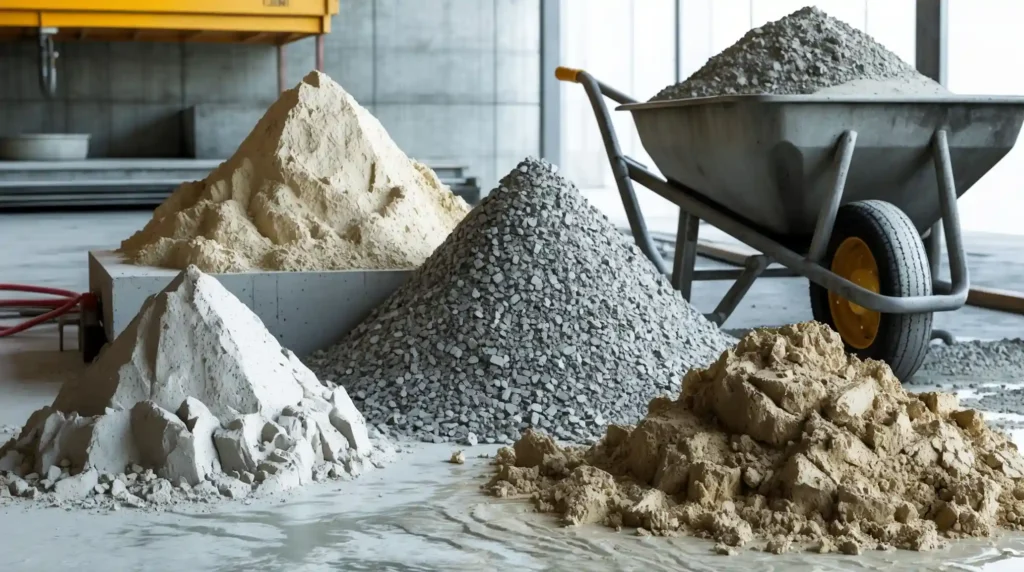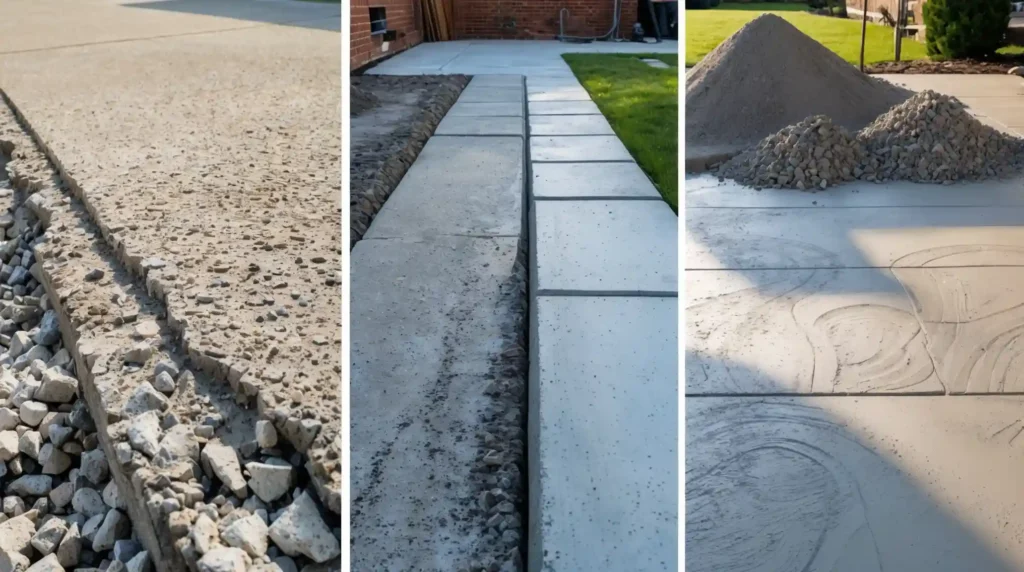Concrete is the most widely used construction material in the world. Many people see it daily, but not everyone knows exactly what it is made of. At its base, concrete is a blend of cement, water, sand, and stone. Together, these ingredients create a strong, lasting material that shapes homes, schools, roads, and bridges. In this blog, we explain what is concrete made of, how each part works, and why understanding the mix matters for projects both big and small.
Understanding Concrete: A Simple Guide
Concrete might look like a single solid block, but it is actually a mixture of several materials. When cement, water, and aggregates (sand and gravel) are blended, they form a paste that hardens over time. This process, known as hydration, makes concrete strong. For thousands of years, builders have used forms of concrete to create structures. The Romans, for example, built aqueducts and temples that still stand today. What makes concrete so powerful is not just its strength but also its flexibility it can be shaped into nearly any form before it sets.
Concrete is used in driveways, sidewalks, buildings, bridges, and even dams. Its popularity comes from the fact that it is affordable, easy to make, and lasts for decades when done correctly. While it may appear simple, concrete’s composition is what gives it its special qualities.
Why Knowing the Ingredients of Concrete Matters

Understanding the ingredients of concrete is important for more than just construction professionals. Homeowners who plan projects, DIY enthusiasts pouring small slabs, and even students learning about materials can all benefit from this knowledge. Each ingredient in concrete plays a role. If one part is out of balance, the mix can fail.
For example, too much water can weaken the finished product, causing cracks. Not enough cement can lead to poor bonding. On the other hand, using the right amounts creates durable concrete that can last for decades. Knowing what makes up concrete also helps people choose the right mix. A homeowner may want smoother concrete for a patio, while a contractor needs stronger concrete for a foundation. Without understanding the basics, it is easy to make costly mistakes.
What Is Concrete Made Of? Breaking It Down
So, what is concrete made of? The clear answer is this: concrete is made of cement, water, sand, and stone. Cement works as the glue. It is usually made by heating limestone and clay together until they form a fine powder. When water is added, a chemical reaction begins, and the cement starts to harden.
Sand and stone, called aggregates, make up the bulk of the mix. Sand fills the small spaces, while larger pieces of gravel or crushed rock provide strength. Together, these parts create a material that can carry heavy loads, resist weather, and last for many years.
In short, concrete is made of cement, water, sand, and stone. These are the essentials, and without them, there is no concrete.
What Ingredients Are in Concrete? The Essential Mix
The essential ingredients in concrete are always the same, though the proportions may change:
- Cement – The main binding ingredient. Most commonly, Portland cement is used. It is gray in color and finely ground.
- Water – Not just any water, but clean water is best. It activates the cement and allows it to spread over aggregates.
- Sand – Fine particles that fill gaps and give the mix texture. Without sand, concrete would be weak and porous.
- Stone or Gravel – These larger aggregates give concrete its bulk and strength. They help resist compression and reduce cracking.
This balance of materials is what makes concrete strong yet workable. Depending on the project, builders may add special admixtures to change how the mix behaves.
Concrete Mix: What’s in It and How It Works

When someone asks what’s in a concrete mix, the answer is not just the ingredients, but also how they work together. The cement and water form a paste that coats each grain of sand and each piece of gravel. When the paste hardens, everything locks into place.
The ratio of each part is important. A common mix is called 1-2-3: one part cement, two parts sand, and three parts gravel, with just enough water to make it workable. Too much water creates weak concrete, while too little makes it hard to pour. Concrete is designed to be strong in compression, meaning it resists heavy loads pressing down. This is why it is ideal for roads, floors, and walls.
Concrete’s ability to be molded before it hardens makes it useful for everything from countertops to skyscrapers. It is truly one of the most versatile building materials ever made.
Main Ingredients in Concrete You Should Know
When learning about the main ingredients in concrete, it helps to focus on the three most important ones:
- Cement – This is what sets and hardens. Without cement, the other materials would never bond.
- Aggregates – Sand, gravel, or crushed stone. These make up most of the volume and add strength.
- Water – The activator that makes cement turn from powder into a binding paste.
Even though additives can be included, these three are always the foundation. Without them, concrete would not exist. Cement provides glue, aggregates give strength, and water brings it all together.
What Makes Up Concrete Beyond the Basics
Modern concrete often includes more than just the main ingredients. Builders add materials called admixtures to change how the concrete behaves. Some examples include:
- Plasticizers to make the mix easier to pour.
- Accelerators to make it cure faster in cold weather.
- Retarders to slow down curing in hot climates.
- Air-entraining agents to make concrete resist freezing and thawing.
In addition, some builders use recycled materials. Fly ash, slag, or silica fume can replace part of the cement. Fibers made of steel, glass, or plastic may also be added to reduce cracking. These extra materials show that what concrete is made up of can be adjusted depending on the needs of the project.
What Does Concrete Consist Of in Everyday Projects?

For everyday projects, the composition of concrete is simple but slightly adjusted. A concrete driveway may have more stone to handle the weight of cars. A sidewalk might use finer sand for a smoother finish. A patio mix may include color additives for a decorative look.
Although the ingredients of concrete are the same, the proportions shift depending on what it is used for. Builders know that the wrong mix can lead to cracks or weak spots. That is why professional advice is important when deciding what mix to use. Concrete might look the same in every project, but what it consists of can vary a lot.
What Materials Are Used to Make Concrete Stronger?
Concrete is naturally strong, but sometimes extra reinforcement is needed. Here are some common methods:
- Rebar (steel bars) – placed inside the pour to handle tension forces.
- Wire mesh – spread across slabs to reduce cracking.
- Fibers – tiny pieces of glass, steel, or synthetic material added for strength.
- Sealants – applied on top to resist water and weather.
These extra materials improve concrete’s durability. A bridge, for example, must handle heavy loads and constant movement. A simple sidewalk may not need as much reinforcement. What materials are used depends on how much strength is required.
Concrete in Stafford, VA: Trusted by Port Solutions DMV
In places like Stafford, VA, concrete is essential for homes, businesses, and public spaces. From driveways to foundations, people expect concrete to last. That is why many trust Port Solutions DMV to handle their projects. With knowledge of what concrete is made of and years of hands-on experience, the company ensures every project is built to last.
Concrete in this area must deal with changing seasons, heavy use, and different soil types. By using the right mix and proper techniques, Port Solutions DMV delivers quality work that homeowners and contractors can rely on.
Key Takeaways: Understanding the Components of Concrete
To put it all together:
- Concrete is made of cement, water, sand, and gravel.
- The mix can include additives to improve performance.
- The ratio of materials determines the strength and durability.
- Everyday projects may adjust the mix slightly for looks or load.
- Reinforcements like rebar and fibers make it even stronger.
Concrete is everywhere around us because it is reliable, affordable, and easy to shape. By knowing what it is made of, you can make smarter choices for your next project. Port Solutions DMV shows how experience and the right materials make all the difference.
Final Thought
Concrete may seem simple, but its strength lies in the careful mix of cement, water, sand, and stone. By understanding its ingredients, you not only learn how this material works but also why it has been trusted for centuries. Whether used in small home projects or large commercial builds, concrete remains the backbone of modern construction. Knowledge of what it is made of helps builders, homeowners, and communities create spaces that last for generations.
If you’re planning a project and want strong, long-lasting results, now is the time to act. Get in touch with our team today and see how the right concrete mix can bring your ideas to life.




